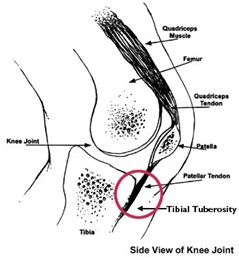Patient Story
Slipped Capital Femoral Epiphysis: Christopher's Story

He didn’t trip. He wasn’t pushed. But a 13-year-old boy doesn’t typically fall down in his living room.
Something was going on with Christopher, and his parents were scared.
He was in excruciating pain. His leg, his hip, his groin. He couldn’t quite pinpoint it. Christopher had been limping on and off for weeks, but the fall was the last straw. His family took him to the Emergency Center at Johns Hopkins All Children’s Hospital.
Joanne, his mother, already had made an appointment with his pediatrician, assuming Christopher, who was an avid baseball player, was dealing with some type of sports injury. That is what they expected to hear at the hospital, until a quick-thinking resident doing rounds in the Emergency Center, noticed something on Christopher’s X-rays and immediately called Drew Warnick, M.D., an expert in orthopaedics.
Warnick recognized what the resident had spotted. Christopher was diagnosed with slipped capital femoral epiphysis (SCFE), a hip condition that occurs in teens—typically boys—who are still growing. The exact cause is not yet known, though weight and family history can play into it, along with an endocrine or metabolic disorder.
Many teens and young adults suffer from a variety of hip disorders and conditions that cause structural abnormalities of the hip joint. If left untreated, these often-painful conditions can lead to early degeneration and premature osteoarthritis of the hip joint in otherwise young, healthy and active individuals. Once severe degeneration and osteoarthritis has occurred, hip replacement is often the only solution.
“I sat down with the family, showed them the X-rays and explained exactly what we were dealing with,” Warnick recalls. “The head of the femur—the thigh—slips off the neck of the femur. It isn’t necessarily sports-related, but it can be brought on by injury or appear on its own. In fact, Christopher’s father had dealt with the same issue when he was a teenager. He still has a slight limp. Our goal was to avoid that for Christopher.”
It was the family’s good fortune they landed where and when they did: Johns Hopkins All Children’s, rated a national Top 50 children’s orthopaedic program by U.S. News & World Report, 2018-2019. In fact, Warnick is the only surgeon in the Tampa Bay area experienced in a new technique that repositions the head of the femur back into the femoral neck without risk of long-term deformity that often leads to a limp and other limitations.
“As a mother, I was devastated to think about what was happening to my son,” Joanne, Christopher’s mom, recalls. “But Dr. Warnick and his team did an outstanding job of educating us on exactly what we could expect, what our options were and what the outcome would be. It was incredibly reassuring. It’s very difficult to see your child in that kind of pain.”
The new procedure—the Modified Dunn—for SCFE requires additional training and involves a completely different and more involved technique that, like any surgery, involves a few risks along with great rewards.
"The Modified Dunn procedure involves actually dislocating the hip and repositioning the head of the femur back onto the neck of the femur where it belongs,” Warnick explains. It requires meticulous surgical technique with experienced hands. The more typical repair involves simply screwing the slipped femur in place to prevent further slippage, without returning it to its original location.
The risk of the Modified Dunn comes in not disturbing the blood supply. The training requires Warnick to keep an eye on the blood supply throughout the procedure. “We don’t want to interrupt it in any way. We also have to keep an eye on the blood supply during the recovery stage, but what is amazing about this procedure is that you are taking away that severe pain, virtually the moment the surgery is over.”
“We have been extremely pleased with the improved outcomes we are seeing in patients who choose this option,” Warnick continues. “And the long-term benefits—putting the femur back together as it was before the slippage—are allowing our patients to go back to their lives, continue on with their sports and activities as normal with no limp, no pain and no long-term effects.” Success rates have been impressive and Warnick, known for this technique, is referred patients from other pediatric orthopedic specialists throughout the area.
Once the surgery is complete, the patient requires proper recovery time but little else by way of therapy or ongoing procedures. Within a few months, Christopher was playing golf and back to his old life. Warnick requested he wait six months before returning to baseball.
Warnick is part of an orthopedic team at Johns Hopkins All Children’s Hospital that is known for a full range of minimally invasive surgeries and techniques that focus on providing cutting-edge joint-preserving treatment options to adolescents and young adults with hip disorders and conditions.
Christopher is now 16, a junior at St. Petersburg High and has just been accepted into the International Baccalaureate program. “It has all been so successful,” Joanne says. “Dr. Warnick gave Christopher back his abilities and he was able to move past this. They took great care of us from the moment we arrived.”
Drew Warnick, M.D., is on the medical staff of Johns Hopkins All Children’s Hospital, Inc. (“JHACH”), but is an independent practitioner who is not an employee or agent of JHACH. JHACH shall not be liable for actions or treatments provided by Dr. Warnick.
Christopher's Doctor
Orthopaedic & Scoliosis Surgery at Johns Hopkins All Children's Hospital
When your child needs orthopaedic care — for anything from a broken bone, to hip or hand surgery, to scoliosis — the pediatric experts in the orthopaedic and scoliosis surgery program at Johns Hopkins All Children’s Hospital in St. Petersburg, Florida, provide the treatment and care to help your child get back to being a kid.





